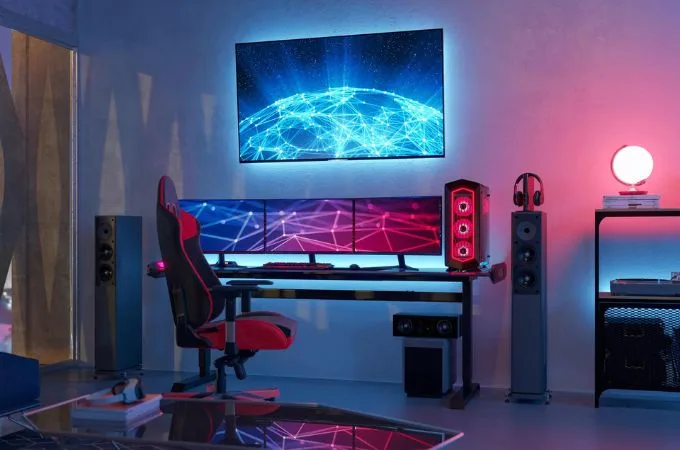How to Set up Dual Monitors – Why Two Monitors are Better than One
Want to boost your productivity? Are you looking for a way to elevate your gameplay? Dual displays offer a better experience than single and are great for multitasking. But how can you set them up? Let’s uncover this in this comprehensive guide!
Even a generous 34-inch monitor can feel cramped when you’ve opened a dozen tabs on your screen. The situation becomes worse when you’re confined to a laptop screen. Fortunately, you can add another display on your desk to clarify things. You can multitask better on dual monitors, compare documents, and complete tasks more quickly. You can easily attach two monitors if your desktop includes two video ports. Windows will recognise the dual monitors and allow you to customise the monitor arrangement based on your tastes and needs.
Let’s discuss how you can set up dual monitors.
Which Cables are Required for Dual Monitors?
The latest monitors have VGA, DVI, HDMI, and DisplayPort ports. In other words, you’ll have numerous options to connect your external monitors. While VGA and DVI cables are typically included with the display, you may need to purchase an HDMI or DisplayPort cable separately to communicate through those options. These cables are inexpensive and widely accessible on Amazon and tech stores like Laptop Outlet.
How to Configure Dual Computer Monitors?
Follow the below-mentioned steps to configure two monitors to display a single workspace.
1. Attach the Monitor Cables
You must plug in your secondary monitor with the power outlet and connect its video cable to the video port on your desktop PC.
2. Configure Windows to Manage Your Dual Displays
Click right on the Windows startup menu and select Screen Resolution (Windows 7 or Windows 8) or Display Settings (Windows 10 or 11). On the results page, you can specify the display arrangement. The pull-down menu of multiple displays allows you to adjust both monitors’ configurations. Click on the “Extend these displays”. It will enable your Windows to handle both displays as one contiguous screen.
3. Set Primary and Secondary Screens
You can tell Windows which monitor will serve as the primary screen or the second.
Here is how you can do this:
- Right-click on your desktop and navigate to “Display settings” from the resulting menu. Click “Display” in the left navigation panel. You’ll see numbered boxes at the top of the page indicating your available monitors, such as box “1” on the left monitor and box “2” on the right.
- From these boxes, choose a monitor you want to use as a “primary screen.”
- Scroll to the bottom and check the box labelled “Make this my main display.” The other monitor will immediately switch to secondary mode.
- Finally, close the settings window by clicking the “X” in the upper right corner.
4. Adjust the Monitor Resolution
Go to the start menu and find the “Display settings”. Your monitors are labelled with numbered boxes at the top of the results page. Each box represents a monitor.
- Navigate to the box of the monitor you want to adjust.
- Scroll to “Display Resolution” and choose your desired resolution from the dropdown box.
- Click the “Keep Changes” button to confirm the changes.
- Mark on the “X” in the top right corner to close the page.
5. Set the Position of Monitors
- Right-click the desktop and select “Display settings.” Some numbered boxes at the top of the page indicate your available monitors.
- Set monitor “1” on the left and monitor “2” on the right if you want the mouse to go from left to right across your monitors.
- Now click, drag, and arrange the numbered boxes per your needs. If you’re not sure which monitor is “1” or “2,” click the “Identify” button. Each monitor will show its allocated number.
- Navigate to “Keep Changes” when you are okay with the settings.
- Lastly, exit the settings page by clicking the “X” in the upper right corner.
Why Two Monitors Are Better than One?
Having a dual monitor setup at your workspace increases performance and productivity. Two monitors at the same desk enhance the productivity of learning apps, office tasks, graphics creation, and various other forms of work.
Let’s uncover their benefits in detail:
Enhanced Productivity
Productivity is the primary benefit of dual monitors over a single one. When you’re working in a remote setting, getting distracted and interrupted over time is straightforward, making having a conscious focus on productivity even more necessary.
So, a dual monitor setup means – more done, more productivity! You can open and view multiple applications on the two screens. For instance, you can use your primary PC monitor for video editing and the secondary monitor for music and emails. You don’t have to switch multiple applications simultaneously. Instead, you can drag and drop them across the screens.
Easier Comparisons
If you have a dual monitor setup, comparing data between two files is a piece of cake. It can be daunting to switch between tabs. However, two screens provide a more fluid workflow and allow for greater attention. You can compare multiple files and projects while using dual monitor settings. You can also write a research proposal on your primary screen while following along with tutorials and instructional videos on the second one.
Minimum Downtime
Nobody can deny that switching between windows on a single-screen laptop or desktop takes much time. Not only does it take time to find or browse an application, but you also need time to access the information, potentially leading to interruptions in concentration and workflow.
According to the research, the average time it takes to complete tasks is significantly lower for people who rely on two screens than people on single screens.
Improved Focus
Dual displays can also help you stay focused. Consider enjoying your favourite song on one screen while working on another project. This configuration lets you focus on your tasks and get things done simultaneously without disrupting your workflow.
Gaming
Dual monitors also elevate your gaming experience. You can easily have a video, audio, or chat window in the background when playing games. Under the hood, if you want to livestream, having a second monitor is vital because it allows you to interact with your audience without interfering with the game.
Final Thoughts
A dual monitor setup can improve your computing experience for work or play. There are plenty of advantages to having two screens over a single monitor. We hope you can easily configure dual computer monitors by following all the steps outlined in this guide.
Whether you’re a remote worker looking for something to enhance productivity or a gamer seeking immersive gameplay, dual monitors are undoubtedly worth consideration.
Laptop Outlet is one of the leading tech stores in the UK. In addition to providing cutting-edge laptops and notebooks, it offers best-in-class monitors from all renowned brands.
Visit the Laptop Outlet to find your dream monitor!







